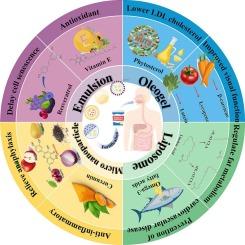酸奶中疏水功能成分的包封:工艺、产品特性及健康益处
IF 8
1区 农林科学
Q1 FOOD SCIENCE & TECHNOLOGY
引用次数: 0
摘要
酸奶作为一种被广泛消费的功能性食品,其亲水性基质与疏水性功能成分之间存在物理不相容性,导致分散不均匀、氧化降解和生物利用度降低。为了应对这些挑战,通常采用乳液、脂质体和微或纳米颗粒等封装系统来提高强化酸奶中疏水生物活性物质的稳定性和功效。包封体系的稳定性受微观参数的影响,包括界面层、颗粒包覆层和颗粒尺寸。促进静电斥力以防止酪蛋白胶束聚集、在酪蛋白网络中填充颗粒和优化液滴大小等策略显著影响酸奶的理化性质,提高功能成分的输送效率。添加疏水功能成分的酸奶受益于其包封结构形成的物理屏障,可以延迟活性成分的氧化降解。这种屏障通过控制释放机制提高了胃肠道的递送效率和生物利用度。这种改善有助于产生积极的健康结果,包括心血管支持、抗氧化防御、抗炎活性和骨骼健康,并可能有助于降低患慢性病的风险。未来的体内研究,特别是涉及人体临床试验的研究,需要为功能性酸奶产品的开发提供信息,并支持跨其他乳制品基质的相关输送系统的应用。本文章由计算机程序翻译,如有差异,请以英文原文为准。

Encapsulation of hydrophobic functional components in yogurt: technology, product characteristics and health benefits
Yogurt, a widely consumed functional food, presents a physical incompatibility between its hydrophilic matrix and hydrophobic functional components, resulting in uneven dispersion, oxidative degradation and reduced bioavailability. To address these challenges, encapsulation systems such as emulsions, liposomes and micro- or nanoparticles are commonly employed to enhance the stability and efficacy of hydrophobic bioactives in fortified yogurt. The stability of encapsulation systems is governed by microscopic parameters, including interfacial layer, particle coating and particle size. Strategies such as promoting electrostatic repulsion to prevent casein micelle aggregation, filling voids within the casein network with particles and optimising droplet size notably influence the physicochemical properties of yogurt and enhance the delivery efficiency of functional components. Yogurt fortified with hydrophobic functional components benefits from a physical barrier formed by its encapsulation structure, which delays the oxidative degradation of active ingredients. This barrier enhances delivery efficiency and bioavailability in the gastrointestinal tract through controlled-release mechanisms. Such improvements contribute to positive health outcomes, including cardiovascular support, antioxidant defence, anti-inflammatory activity and bone health, and may help reduce the risk of chronic diseases. Future in vivo studies, particularly those involving human clinical trials, are needed to inform the development of functional yogurt products and to support the application of related delivery systems across other dairy matrices.
求助全文
通过发布文献求助,成功后即可免费获取论文全文。
去求助
来源期刊

Food Research International
工程技术-食品科技
CiteScore
12.50
自引率
7.40%
发文量
1183
审稿时长
79 days
期刊介绍:
Food Research International serves as a rapid dissemination platform for significant and impactful research in food science, technology, engineering, and nutrition. The journal focuses on publishing novel, high-quality, and high-impact review papers, original research papers, and letters to the editors across various disciplines in the science and technology of food. Additionally, it follows a policy of publishing special issues on topical and emergent subjects in food research or related areas. Selected, peer-reviewed papers from scientific meetings, workshops, and conferences on the science, technology, and engineering of foods are also featured in special issues.
 求助内容:
求助内容: 应助结果提醒方式:
应助结果提醒方式:


